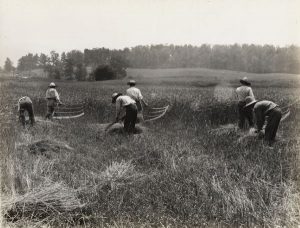The Wheat Activity

- >
- Teachers
- >
- Teacher Resources
- >
- Lesson Plans
- >
- Economics for Leaders
- >
- The Wheat Activity

Lesson Description:
In this simulation students are workers producing wheat. The students will use their available capital (pencils) to produce wheat by writing the word “w-h-e-a-t” as many times on the piece of paper (land) as possible in a given time period. Each round more students are added to each team which will slow down production and show how even as total product increases the marginal productivity of workers does not increase at that same rate. Students will use this activity and marginal decision making to understand how companies make decisions to hire based on marginal productivity.
Voluntary National Content Standards
Standard 2: Marginal Decision Making
Effective decision making requires comparing the additional costs of alternatives with the additional benefits. Most choices involve doing a little more or a little less of something; few choices are all-or-nothing decisions.
- To produce the profit-maximizing level of output and hire the optimal number of workers and other resources, producers must compare the marginal benefits and marginal costs of producing a little more with the marginal benefits and marginal costs of producing a little less.
Time Required: 10 – 15 minutes
Materials:
- 10-15 pieces of plain 8.5 x 11 paper (land)
- Students divided up into 2+ teams (labor)
- Pencils (capital)
- Tape
- Prize of some sort for the winning team (Extra credit, candy, etc.)
Concepts:
- Diminishing Marginal Productivity
- Productive Resources
- Productivity
- Scarcity
Procedure:
- Start by dividing the students into at least 2 groups. Tape as many pieces of paper on a wall as there are teams. This will be their farming land.
- Remind students about productive resources and explain that in this activity they will be producing wheat. They will be the labor. Their pencils are the capital. The paper taped to the wall is the land.
- Ask for one (1) volunteer from each team.
- Give the following instructions to the students:
- Each round you’ll be producing as much wheat as possible. To do so you’ll write the word “W-H-E-A-T” out correctly, legibly, and carefully. Each round will last 20 seconds.
- After each round track the number of “wheat” each team made. You’ll want to keep track in a table:
Labor (Q) Total Production of Wheat (TP) Round 1 Round 2 Round 3 - After Round 1, replace the piece of paper with a fresh piece of paper. Students may ask to change the location/height, orientation of the paper. Do not do so! Land cannot just simply be changed and sometimes you have to make due with what you have.
- Invite another person from each team for Round 2. After the round record to total production with the two workers.
- Repeat steps 3 and 4 as many times as you’d like. You may also want to increase the number of students more than 1 at a time. For example, in Round 1 there is 1 person per team, in Round 2 there are 2 people per team, then in Round 3 you add 2 for a total of 4 per team. You want to make sure you add enough people that is becomes difficult for the students to keep writing and a crowding each other.
- At the end of the game tally up the total amount to wheat and award the winning team their prize.
Debrief
1. Have the students create a final column calculating the Marginal Productivity (MP)
| Labor (QL) | Total Production of Wheat (TP) | Marginal Production (MP) | |
| Round 1 | |||
| Round 2 | |||
| Round 3 |
2. What do you notice about the TP column? (This should be increasing—there should be more wheat being produced but the rate will decline. TP increases at a decreasing rate)
3. Ask the students what they notice about the MP?
4. Why would they expect that? (Common answers will include they were crowded and getting in the way of each other—take this time to explain that MP increases for a little bit each worker up to a point adds more to production but at some point the MP will start to decrease.)
5. How does this relate to a job you know about?
6. Is this always the case? Do firms all have the same point where MP will decline? (No. Things like the size of the factory or the capital used will affect the productivity of the firm and its workers.)
7. How does diminishing marginal productivity influence the decisions of business owners? (They won’t hire more workers if MP is negative.)
8. Producers compare the marginal benefit with the marginal cost when deciding to hire another worker. In this activity is MP the benefit or the cost? (MP is the benefit of hiring an additional worker? Their wage would be the additional cost.)
9. Optional:
- Suppose each unit of wheat produced is sold for $2, fill out the following table and answer the question below:
Note:
- Total Revenue=price x quantity
- MRP = ?TR/?QL
| Labor (QL) | Total Production of Wheat (TP) | Marginal Production (MP) | Total Revenue | Marginal Revenue Product (MRP) | |
| Round 1 | |||||
| Round 2 | |||||
| Round 3 |
How many workers should be hired if the wages are $5, $10, $25 (Teacher may want to adjust wages based on the total product from the classes—the goal is to get the students to compare the MRC (labor cost) to the MRP.
Conclusion:
Production increases as more labor is added but eventually there is a point where each additional worker add less and less to the firm in terms of production. Total productivity of workers increases at a decreasing rate. Marginal productivity increase and then decreases as too many workers are added and they begin to crowd out each other.
Lesson created by Dr. Jamie Wagner
© Foundation for Teaching Economics, 2018. Permission granted to copy for educational use

Making Economics Meaningful for Students
The Fund for American Studies’ Liberty and Leadership podcast features FTE’s own Amanda Stiglbauer, a longtime member of our team who recently…

From Student to Leader: Bret’s Transformative Experience at the EFL Program at UC Berkeley
November 13, 2025 Bret Chen had always been drawn to the world of business. As a high school junior from…

Aditi Gandhi: Economics for Leaders Virtual Program Alumni
October 6, 2025 Aditi sat at her desk in Dubai, staring at her computer screen, her fingers hovering over the…

